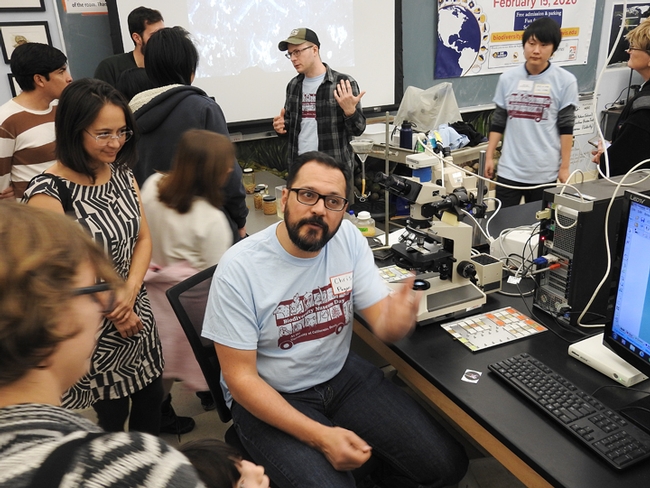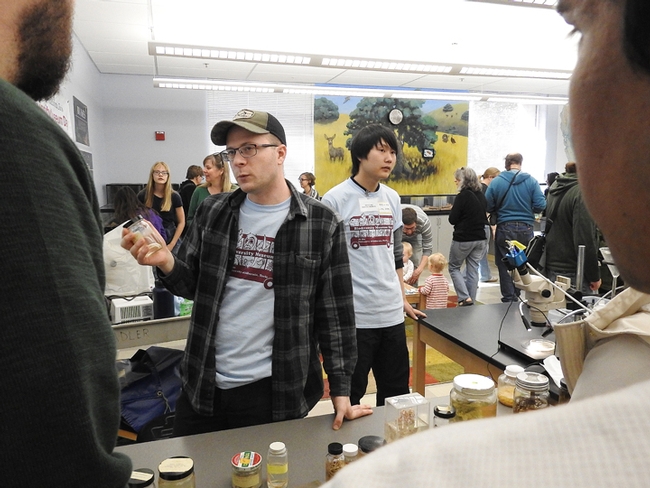
If you're a gardener, you're aware that nematodes are "microscopic, eel-like roundworms" and that "most troublesome species in the garden are those that live and feed within plant roots most of their lives and those that live freely in the soil and feed on plant roots," according to the UC Integrated Pest Management Program website on nematodes.
If you attended the ninth annual UC Davis Biodiversity Museum Day, you learned hands-on information from nematologists Christopher Pagan and Corwin Parker, doctoral students who study with major professor Steve Nadler, professor and chair of the UC Davis Department of Entomology and Nematology.
Pagan and Parker held forth at their display in the Academic Surge Building, where they fielded questions about nematodes and showed specimens to the visitors. The nematode collection was one of 13 museums or collections featured at the Biodiversity Museum Day, always held the Saturday of Presidents' Weekend.
Many visitors asked what nematodes are, they related.
Other common questions asked:
- Do I have nematode parasites?
- How dangerous are nematode parasites/can they kill you?
- How long do they live?
- How many species ofode are there?
- Are soil nematodes good or bad for my garden?
Parker shared some of the answers:
Do I have nematode parasites?
Probably not unless you've been traveling a lot. The most common nematode parasite of humans in the US is pinworm which most children get, but not adults. Worldwide however, hundreds of millions of people are infested with parasites including Ascaris, hookworm, and whipworm.
How dangerous are nematode parasites/can they kill you?
Nematode parasites are usually relatively benign unless you have a lot of them. Potentially fatal exceptions do exist, such as zoonotic infections of rat lungworm and raccoon roundworm, but those are rare.
How long do nematodes live?
It depends on the species and life history. Parasitic nematodes can live for a long time, while most free-living nematodes have relatively short lifespans. Some nematodes that live in harsh environments such as deserts can extend their lives by going into a state of suspended animation until environmental conditions are optimal.
How many species of nematode are there?
More than 30,000 described species, but it's estimated there are more than 1 million total.
Are soil nematodes good or bad for my garden?
Most soil nematodes are neutral to beneficial for your garden. They're an integral part of the soil ecosystem and help with nutrient cycling, and some kill of root-feeding insects. There are some plant-parasitic nematodes, but most don't cause significant damage.
UC Davis Biodiversity Museum Day
In addition to the nematode collection, the UC Davis Department of Entomology and Nematology showcased the Bohart Museum of Entomology and the Häagen-Dazs Honey Bee Haven. Other participating museums or collections at this year's Biodiversity Museum Day: the Botanical Conservatory, Arboretum and Public Garden, California Raptor Center, Museum of Wildlife and Fish Biology, Paleontology Collection, Phaff Yeast Culture Collection, Viticulture and Enology Culture Collection, Anthropology Museum, Center for Plant Diversity, and Marine Invertebrate Collection.
Here's a glimpse of the Biodiversity Museum Day activities at the Bohart Museum of Entomology and the Häagen-Dazs Honey Bee Haven.
If you missed it, calendar the 10th anniversary Biodiversity Museum Day in 2021. The event always takes place the Saturday of Presidents' Day Weekend.
Attached Images:

Nematologists Christopher Pagan (foreground) and Corwin Parker, doctoral students in the UC Davis Department of Entomology and Nematology, answer questions from the crowd at the UC Davis Biodiversity Museum Day. (Photo by Kathy Keatley Garvey)

Nematologist Corwin Parker, doctoral student, UC Davis Department of Entomology and Nematology, answers a question about nematode parasites. (Photo by Kathy Keatley Garvey)